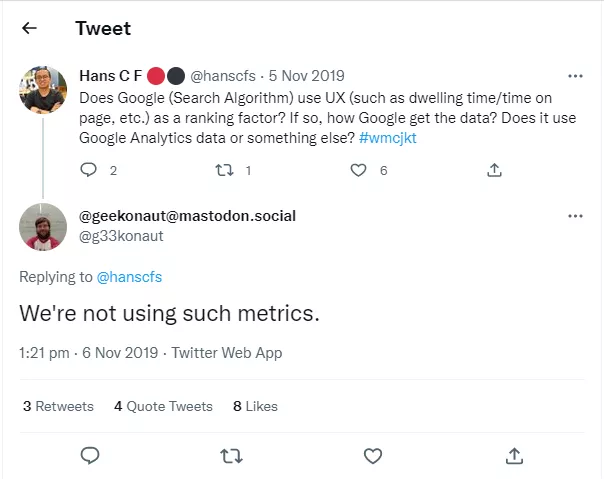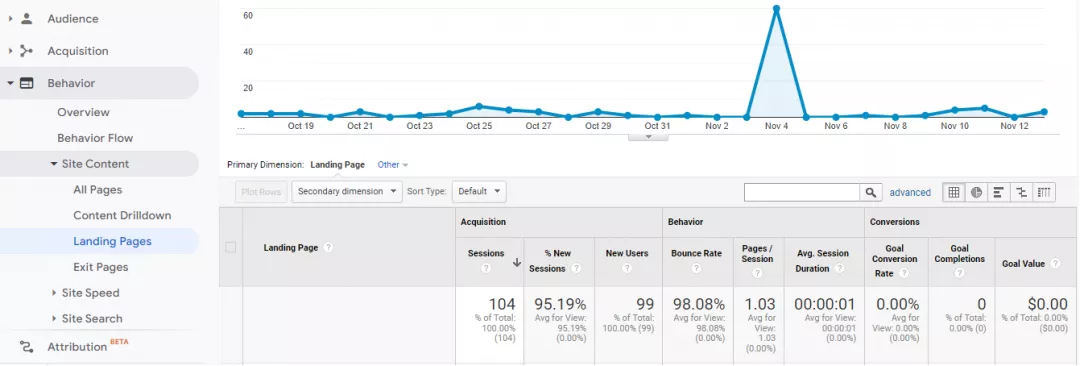What is Dwell Time?
Dwell time is the amount of time a user spends on a web page after clicking a link on search results before returning to SERPs.
For instance, a user searches for a particular query in a search engine and clicks a link in the search results. After spending ten seconds on that website, the user clicks back to SERPs. So the dwell time here is ten seconds.
Some people think dwell time is the same as Bounce Rate and Average Time on Page, but there is a difference among all these.
Dwell Time vs Bounce Rate
Dwell time and bounce rate seem similar, but certainly, they are not.
Bounce rate is the percentage of visitors who click on your website and leave it without performing any further action - like navigating through a page, filling out a form, or adding any product to their shopping cart.
In dwell time, visitors must come from and return to organic search results, but in bounce rate, all visitors do not necessarily come from the SERP.
Even if they come from SERP, they can navigate directly to another website or shut down your page. If a user spends even an hour on your website without clicking any other link and leaving it, it will still qualify as a bounce.
Google uses tracking ID for every page on a website. When a searcher visits a website and leaves it without performing any further action, your session will expire, and Google will mark it as a bounce.
Dwell Time vs Average Time on Page
Dwell time is different from the Average Time on Page.
Average Time on Page is the average amount of time visitors spend on your web pages before going back or visiting another page or website.
This time is calculated based on two clicks – one that directs users to a web page and another that directs them away from that page.
Users can access this web page from an email link, organic results, ads, social media, or any other source.
Remember, if a person does not go to another page and clicks back, the Average Time on Page is calculated as zero.
Bounce rate and Average Time on Page are not solely based on SERPs – links from other sources are also considered.
Dwell Time vs Session Duration
Dwell time is also different from session duration.
Session duration is the active time users spend on your website until they exit or remain inactive for a specified time (30 minutes of inactivity by default).
However, if a user remains inactive on the last page, this session will be excluded from the total and marked as zero.
Session duration accumulates all the sessions - including time spent on different pages and sessions where users bounced back without taking further action – and calculates their average.
Dwell Time | Bounce Rate | Average Time on Page | Session Duration |
|---|---|---|---|
|
|
|
|
|
|
|
|
|
|
Put simply:
Dwell time is the time spent on a website after clicking on a search result. It is SERPs-based, and links from other sources are not included.
Bounce rate is the percentage of visitors who leave a website without clicking any other link – no matter how much time they spend on a website.
Average Time on Page is the average time users spend on your web Pages. It starts when someone clicks on a link and ends when someone exits this page.
Session Duration accumulates all the active sessions on your entire website within a specified time and calculates their average.
Is dwell time a ranking factor?
While it's widely accepted that dwell time affects Google ranks, the search engine giant has never publicly stated that it is a ranking factor.
When you see Google Analytics, you will find the Session Duration and Bounce Rate, but you will not find the Dwell Time.
Google’s John Mueller (Webmaster Trends Analyst) responded to that question during a live hangout on YouTube:
Q: To be 100% clear, Google is not using click data, behavioural data, pogo-sticking, that type of stuff directly in their search ranking algorithm for ranking websites in their search results?
A: As far as I know, we don’t use that.
Citation
Watch John Mueller talking about this at the 05:16 minute mark.
Here is the link to this video.
Martin Splitt of Google also refuted this hypothesis, claiming that Google does not employ user interaction metrics.

The reason can be that dwell time is not a reliable measure of user satisfaction. There are plenty of scenarios where dwell time does not indicate the quality of a website and user satisfaction.
For instance, when someone is looking for a weather forecast or contact information, or when they immediately find the information they were looking for, or even when the content is not informative - the dwell time will be short.
Contrary, the dwell time will be longer if a user finds your content thin or weak and has to struggle to find the correct information.
In all these scenarios, dwell time does not indicate the content's quality or user satisfaction.
Google has consistently refuted claims that dwell time, or any other user metric, affects search engine results.
However, SEO experts claim it is a ranking factor. They say it impacts your website ranking as it tells the search engine whether your pages offer value to the searchers.
Google may not be concerned about dwell time, but it is concerned about user experience. Therefore, dwell time might be a helpful tool for determining how satisfied visitors are with the information on your website.
How to measure dwell time?
There is no way to calculate the dwell time directly. However, you can use Google Analytics to see the Average Session Duration. That will give you an idea about the average time spent on your website after a visitor lands on your pages.
Here is how you can do this:
Log in to your Google Analytics Account and click Behavior > Site Content > Landing Pages
Create a New Segment and specify Organic Traffic
Here you will see the Avg. Session Duration

This information will help you see the performance of your content. You will get an idea of what works for you and what does not.
If some pages have less Average Session Duration, you may see them. It might have issues with page speed, or it may have poor-quality content. You can always take measures to improve the time spent on your web pages.
How to improve dwell time?
Believe it or not, improving dwell time can positively impact your website. However, it doesn't matter whether it is a ranking factor; you can still work on improving dwell time to enhance user experience.
Focus on delivering helpful content for your readers. Make sure it is easy to find, comprehensive and gives the exact answer to searchers' queries.
Avoid hiding answers to queries on a page beneath a huge header image.
Embed videos related to your content.
Always keep search intent in mind. When people are searching for something, they have a particular intent in their mind. It is impossible to cover all the aspects of a topic every time, but providing as many answers as possible can significantly improve your dwell time.
Searchers want to avoid seeing old content. Keeping your website content up to date and changing it now and then will help you increase your dwell time.
Add valuable resources to your website content by providing internal links to your pages. Searchers are less likely to hit back if they find relevant content or answers to their queries on a website.
Takeaway
Dwell time measures the time spent on your website. Whether dwell time is a ranking factor or not; decreasing your bounce rate and increasing the amount of time visitors spend on your website will positively impact your website.
Taking suitable measures will provide visitors with a more engaging experience and ultimately improve your website ranking.


